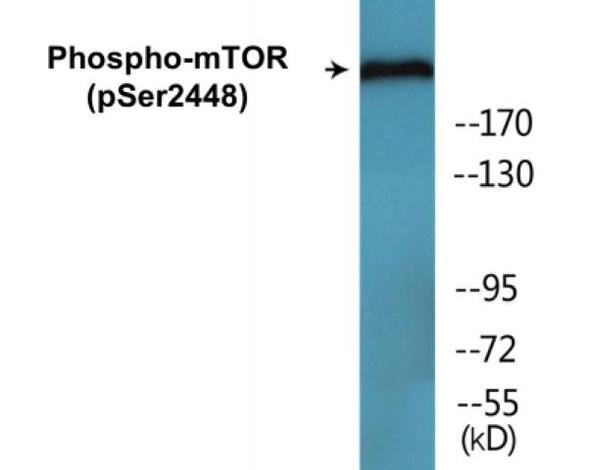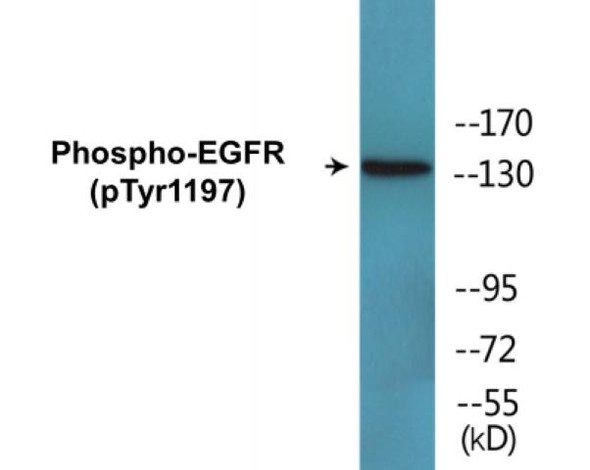Description
mTOR (Phospho-Thr2446) Cell-Based ELISA Kit
The mTOR (Phospho-Thr2446) Cell-Based ELISA Kit is a convenient, lysate- free, high throughput and sensitive assay kit that can monitor mTOR phosphorylation and expression profile in cells. The kit can be used for measuring the relative amounts of phosphorylated mTOR in cultured cells as well as screening for the effects that various treatments, inhibitors (ie. siRNA or chemicals), or activators have on mTOR phosphorylation.
How does our mTOR (Phospho-Thr2446) Fluorometric Cell-Based ELISA Kit work?
Qualitative determination of mTOR (Phospho-Thr2446) concentration is achieved by an indirect ELISA format. In essence, mTOR (Phospho-Thr2446) is captured by mTOR (Phospho-Thr2446)-specific primary (1°) antibodies while Dye 1-conjugated and Dye 2-conjugated secondary (2°) antibodies bind the Fc region of the 1° antibody. Through this binding, the dye conjugated to the 2° antibody can emit light at a certain wavelength given proper excitation, hence allowing for a fluorometric detection method. Due to the qualitative nature of the Cell-Based ELISA, multiple normalization methods are needed:
| 1. | A monoclonal antibody specific for human GAPDH is included to serve as an internal positive control in normalizing the target RFU values. |
| 2. | An antibody against the nonphosphorylated counterpart of mTOR (Phospho-Thr2446) is also provided for normalization purposes. The RFU values obtained for non-phosphorylated mTOR can be used to normalize the RFU value for phosphorylated mTOR. |
mTOR (Phospho-Thr2446) Fluorometric Cell-Based ELISA Kit -Information
| Product Name: | mTOR (Phospho-Thr2446) Fluorometric Cell-Based ELISA Kit |
| Product Code/SKU: | FBCAB00056 |
| Description: | The mTOR (Phospho-Thr2446) Fluorometric Cell-Based Phospho ELISA Kit is a convenient, lysate-free, high throughput and sensitive assay kit that can monitor mTOR (Phospho-Thr2446) protein phosphorylation and expression profile in cells. The kit can be used for measuring the relative amounts of phosphorylated mTOR (Phospho-Thr2446) in cultured cells as well as screening for the effects that various treatments, inhibitors (ie. siRNA or chemicals, or activators have on MTOR phosphorylation. |
| Dynamic Range: | > 5000 Cells |
| Detection Method: | Fluorometric |
| Storage/Stability: | 4°C/6 Months |
| Reactivity: | Human, Mouse, Rat |
| Assay Type: | Cell-Based ELISA |
| Database Links: | Gene ID: 2475, UniProt ID: P42345, OMIM #: 601231, Unigene #: Hs.338207 |
| Format: | Two 96-Well Plates |
| NCBI Gene Symbol: | MTOR |
| Sub Type: | Phospho |
| Target Name: | Phospho-mTOR (Thr2446) |
Kit Principle
Figure: Schematic representation of Assay Genie Cell-Based Fluorometric ELISA principle
Kit components | Quantity |
| 96-Well Black Cell CultureClear-Bottom Microplate | 2 plates |
| 10X TBS | 24 ml |
| Quenching Buffer | 24 ml |
| Blocking Buffer | 50 ml |
| 15X Wash Buffer | 50 ml |
| Primary Antibody Diluent | 12 ml |
| 100x Anti-Phospho Target Antibody | 60 µl |
| 100x Anti-Target Antibody | 60 µl |
| Anti-GAPDH Antibody | 110 µl |
| Dye-1 Conjugated Anti-Rabbit IgG Antibody | 6 ml |
| Dye-2 Conjugated Anti-Mouse IgG Antibody | 6 ml |
| Adhesive Plate Seals | 2 seals |
Additional equipment and materials required
The following materials and/or equipment are NOT provided in this kit but are necessary to successfully conduct the experiment:
- Fluorescent plate reader with two channels at Ex/Em: 651/667 and 495/521
- Micropipettes capable of measuring volumes from 1 µl to 1 ml
- Deionized or sterile water (ddH2O)
- 37% formaldehyde (Sigma Cat# F-8775) or formaldehyde from other sources
- Squirt bottle, manifold dispenser, multichannel pipette reservoir or automated microplate washer
- Graph paper or computer software capable of generating or displaying logarithmic functions
- Absorbent papers or vacuum aspirator
- Test tubes or microfuge tubes capable of storing ≥1 ml
- Poly-L-Lysine (Sigma Cat# P4832 for suspension cells)
- Orbital shaker (optional)
Kit Protocol
This is a summarized version of the kit protocol. Please view the technical manual of this kit for information on sample preparation, reagent preparation and plate lay out.
| 1. | Seed 200 µl of desired cell concentration in culture medium into each well of the 96-well plates. For suspension cells and loosely attached cells, coat the plates with 100 µl of 10 µg/ml Poly-L-Lysine (not included) to each well of a 96-well plate for 30 minutes at 37°C prior to adding cells. |
| 2. | Incubate the cells for overnight at 37°C, 5% CO2. |
| 3. | Treat the cells as desired. |
| 4. | Remove the cell culture medium and rinse with 200 µl of 1x TBS, twice. |
| 5. | Fix the cells by incubating with 100 µl of Fixing Solution for 20 minutes at room temperature. The 4% formaldehyde is used for adherent cells and 8% formaldehyde is used for suspension cells and loosely attached cells. |
| 6. | Remove the Fixing Solution and wash the plate 3 times with 200 µl 1x Wash Buffer for 3 minutes. The plate can be stored at 4°C for a week. |
| 7. | Add 100 µl of Quenching Buffer and incubate for 20 minutes at room temperature. |
| 8. | Wash the plate 3 times with 1x Wash Buffer for 3 minutes each time. |
| 9. | Dispense 200 µl of Blocking Buffer and incubate for 1 hour at room temperature. |
| 10. | Wash 3 times with 200 µl of 1x Wash Buffer for 3 minutes each time. |
| 11. | Add 50 µl of Primary Antibody Mixture P to corresponding wells for mTOR (Phospho-Thr2446) detection. Add 50 µl of Primary Antibody Mixture NP to the corresponding wells for total mTOR detection. Cover the plate with parafilm and incubate for 16 hours (overnight) at 4°C. If the target expression is known to be high, incubate for 2 hours at room temperature. |
| 12. | Wash 3 times with 200 µl of 1x Wash Buffer for 3 minutes each time. |
| 13. | Add 50 ul of Secondary Antibody Mixture to corresponding wells and incubate for 1.5 hours at room temperature in the dark. |
| 14. | Wash 3 times with 200 µl of 1x Wash Buffer for 3 minutes each time. |
| 15. | Read the plate(s) at Ex/Em: 651/667 (Dye 1) and 495/521 (Dye 2). Shield plates from direct light exposure. |
| 16. | Wash 3 times with 200 µl of 1x Wash Buffer for 5 minutes each time. |
mTOR (Phospho-Thr2446) - Protein Information
| UniProt Protein Function: | mTOR: an atypical kinase belonging to the PIKK family of kinases. Is the catalytic subunit of two protein complexes, mTORC1 and mTORC2. mTORC1 activates S6K and inactivates 4E-BP1, up-regulating protein synthesis. mTORC1 contains Raptor, a positive regulatory subunit and scaffold for recruiting substrates, two negative regulators, PRAS40 and DEPTOR, and mLST8; it is a target for the cell-cycle arrest and immunosuppressive effects of the FKBP12-rapamycin complex. mTORC2, a downstream effector of PI3K, is insensitive to rapamycin and activates Akt by phosphorylating a key activation site. mTORC2 contains regulatory subunits Rictor and mSIN1, PROTOR, mLST8, and the negative regulator DEPTOR. mTORC1 suppresses PI3K activity via a strong negative feedback loop that involves S6K1. Inhibiting mTORC1 ablates this negative feedback loop and potentiates PI3K signaling. Known inhibitors of mTOR include rapamycin, temsirolimus (CCI-779). |
| UniProt Protein Details: | Protein type:Protein kinase, atypical; Motility/polarity/chemotaxis; Protein kinase, Ser/Thr (non-receptor); Autophagy; EC 2.7.11.1; Kinase, protein; ATYPICAL group; PIKK family; FRAP subfamily Chromosomal Location of Human Ortholog: 1p36.2 Cellular Component: cell soma; cytoplasm; cytosol; dendrite; endomembrane system; endoplasmic reticulum membrane; Golgi membrane; lysosomal membrane; lysosome; membrane; mitochondrial outer membrane; nucleoplasm; phosphoinositide 3-kinase complex; PML body; TORC2 complex Molecular Function:ATP binding; drug binding; kinase activity; phosphoprotein binding; protein binding; protein domain specific binding; protein kinase binding; protein serine/threonine kinase activity; ribosome binding Biological Process: 'de novo' pyrimidine base biosynthetic process; brain development; cardiac muscle cell development; cardiac muscle contraction; cell aging; cell cycle arrest; cell growth; cellular response to nutrient levels; DNA repair; energy reserve metabolic process; epidermal growth factor receptor signaling pathway; fibroblast growth factor receptor signaling pathway; gene expression; germ cell development; growth; heart morphogenesis; innate immune response; insulin receptor signaling pathway; long-term memory; macroautophagy; maternal process involved in pregnancy; mRNA stabilization; multicellular organism growth; negative regulation of autophagy; negative regulation of cell size; negative regulation of muscle atrophy; negative regulation of NFAT protein import into nucleus; negative regulation of protein amino acid phosphorylation; negative regulation of protein ubiquitination; nerve growth factor receptor signaling pathway; peptidyl-serine phosphorylation; peptidyl-threonine phosphorylation; phosphoinositide-mediated signaling; phosphorylation; positive regulation of actin filament polymerization; positive regulation of endothelial cell proliferation; positive regulation of lipid biosynthetic process; positive regulation of neuron maturation; positive regulation of nitric oxide biosynthetic process; positive regulation of oligodendrocyte differentiation; positive regulation of peptidyl-tyrosine phosphorylation; positive regulation of protein amino acid phosphorylation; positive regulation of protein kinase B signaling cascade; positive regulation of smooth muscle cell proliferation; positive regulation of stress fiber formation; positive regulation of transcription from RNA polymerase III promoter; positive regulation of translation; post-embryonic development; protein amino acid autophosphorylation; protein amino acid phosphorylation; protein catabolic process; regulation of actin cytoskeleton organization and biogenesis; regulation of carbohydrate utilization; regulation of fatty acid beta-oxidation; regulation of glycogen biosynthetic process; regulation of GTPase activity; regulation of myelination; regulation of osteoclast differentiation; regulation of protein kinase activity; regulation of response to food; response to amino acid stimulus; response to cocaine; response to morphine; response to nutrient; response to stress; ruffle organization and biogenesis; signal transduction; social behavior; spinal cord development; T cell costimulation; TOR signaling pathway; transcription initiation from RNA polymerase II promoter; vascular endothelial growth factor receptor signaling pathway; visual learning; voluntary musculoskeletal movement; wound healing |
| NCBI Summary: | The protein encoded by this gene belongs to a family of phosphatidylinositol kinase-related kinases. These kinases mediate cellular responses to stresses such as DNA damage and nutrient deprivation. This protein acts as the target for the cell-cycle arrest and immunosuppressive effects of the FKBP12-rapamycin complex. The ANGPTL7 gene is located in an intron of this gene. [provided by RefSeq, Sep 2008] |
| UniProt Code: | P42345 |
| NCBI GenInfo Identifier: | 1169735 |
| NCBI Gene ID: | 2475 |
| NCBI Accession: | P42345.1 |
| UniProt Secondary Accession: | P42345,Q4LE76, Q5TER1, Q6LE87, Q96QG3, Q9Y4I3, |
| UniProt Related Accession: | P42345 |
| Molecular Weight: | 288,892 Da |
| NCBI Full Name: | Serine/threonine-protein kinase mTOR |
| NCBI Synonym Full Names: | mechanistic target of rapamycin |
| NCBI Official Symbol: | MTOR |
| NCBI Official Synonym Symbols: | SKS; FRAP; FRAP1; FRAP2; RAFT1; RAPT1 |
| NCBI Protein Information: | serine/threonine-protein kinase mTOR |
| UniProt Protein Name: | Serine/threonine-protein kinase mTOR |
| UniProt Synonym Protein Names: | FK506-binding protein 12-rapamycin complex-associated protein 1; FKBP12-rapamycin complex-associated protein; Mammalian target of rapamycin; mTOR; Mechanistic target of rapamycin; Rapamycin and FKBP12 target 1; Rapamycin target protein 1 |
| Protein Family: | Serine/threonine-protein kinase |
| UniProt Gene Name: | MTOR |
| UniProt Entry Name: | MTOR_HUMAN |







